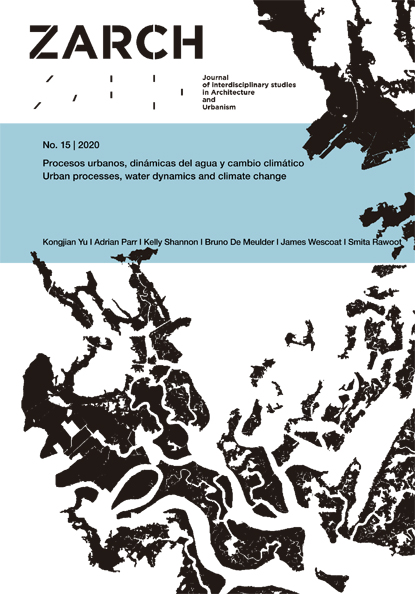Limit Geometries of Architectural Filters: Precise Rationality and Poetic Emotion
DOI:
https://doi.org/10.26754/ojs_zarch/zarch.2020154648Keywords:
limit, Architectural Atmospheres, Architectural Filters, Visual Interference, Phenomena of Interference, LimitAbstract
An architectural filter is a porous material construction that regulates transverse visual relationships, and establishes degrees of connection through the intervention of light and gaze. Filtering boundaries display variable proportions of mass and air, which are instrumental to the production of the spatial experience behind the mediation of matter and geometry. A filter's structural system synthesizes geometric relations with the capacity to cause architectural atmospheres, as a result of the active border that is technically precise and sensorially ambiguous at the same time. The text sustains that the emerging atmospheres behind the filter cannot take place without a previous, precise geometric production; the poetic dimension of filtering strategies originates from its capacity to transform the concrete geometry of its contour conditions and controlled material execution into an unexpected atmosphere of emotional and incommensurable qualities.
Downloads
References
Allen, Stan. 1985. "Field Conditions," Points and Lines. Diagrams and Projects for the City. New York: Princeton Architectural Press.
Arnold, B. H. 1962. Intuitive Concepts in Elementary Topology. Englewood Cliffs, N.J.: Prentice-Hall.
Bertin, Jacques. 1967. Sémiologie Graphique. Les diagrames, les réseaux, les cartes (Semiology of Graphics: Diagrams, Networks, Maps) (with Marc Barbut et al). Paris: Gauthier-Villars.
Calvino, Italo. 1985. Six Memos for the Next Millennium. Milan: Eunaudi.
Chomsky, Noam; Piaget, Jean. 1980. Théories du language – Théories de l’apprentissage. (Theories of Language – Thearies of Learning). Paris: Du Seuil.
Díaz Moreno, Cristina; García Grinda, Efrén. 2004. "Ocean of Air," El Croquis 121/122. Madrid: El Croquis.
Gil Pita, Luis. 2001. "Desde el límite y la frontera," Circo 2001.90. Madrid: Circo.
Habraken, N. J. 2000. The Structure of the Ordinary. (Jonathan Teicher, ed.). Cambridge: MIT Press.
Heidegger, Martin. 1971. “Building, Dwelling, Thinking,” Poetry, Language, Thought. New York: Harper & Row.
Le Corbusier. 1953. The Modulor. London: Faber and Faber.
Le Ricolais, Robert. 1966. "Introduction to the Notion of Form," Data: Directions in Art, Theory and Aesthetics. Greenwich:
New York Graphic Society Ltd.
Le Ricolais, Robert. 1997. Visions and Paradox. Madrid: Fundación Cultural COAM.
Lévi-Strauss, Claude. 1962. La pensée sauvage. Paris: Plon.
Martí Arís, Carlos. 2008. "Tres paseos por las afueras," EAR 1. Barcelona: UPC.
Navarro Baldeweg, Juan. 1995. "El objeto es una sección. La geometría complementaria," Circo 1995.25. Madrid: Circo.
Neumeyer, Fritz. 1995. Mies van der Rohe. La palabra sin artificio. Reflexiones sobre arquitectura 1922/1968. Madrid: El Croquis.
Ortega y Gasset, José. 1957. Viajes y países. Madrid: Revista de Occidente.
Pallasmaa, Juhani. 1996. The Eyes of the Skin. Architecture and the Senses. New York: John Wiley & Sons.
Maria Rilke, Rainer. 1921. Mitsou. Histoire d'un chat. Paris: Rivage.
Sosa Díaz-Saavedra, José Antonio. 2006. "Condiciones de contorno," Arquitectura COAM, 345. Madrid: COAM.
Stanley Smith, Cyril. 1964. "Structure, Substructure, Superstructure," Structure in Art and Science. New York: George Braziller.
Wagensberg, Jorge. 2004. La Rebelión de las Formas. Barcelona: Tusquets.
Wittgenstein, Ludwig. 1921. Tractatus Logico-Philosophicus.
Zellini, Paolo. 1980. Breve storia dell'infinito. Milan: Adelphi.


